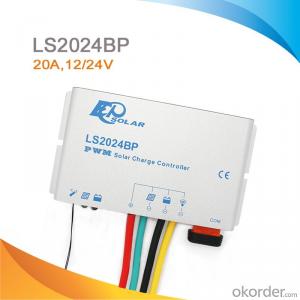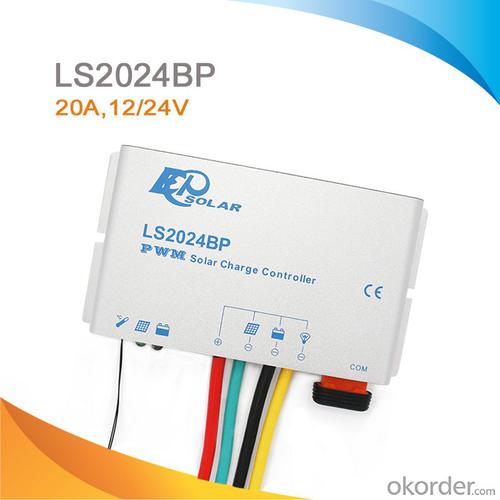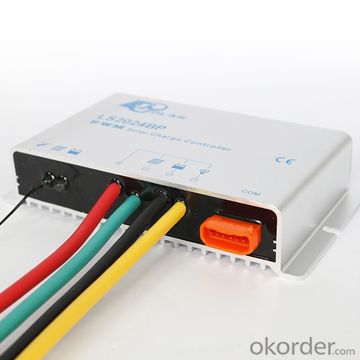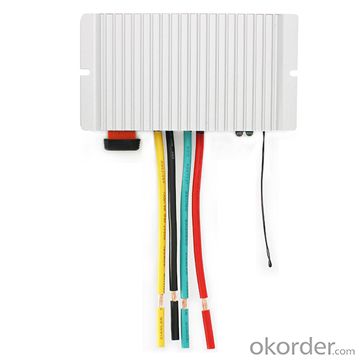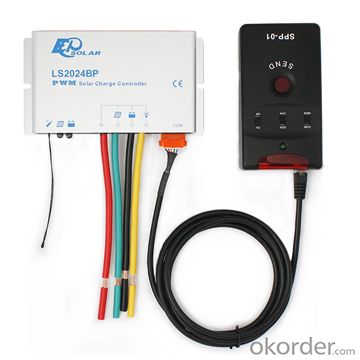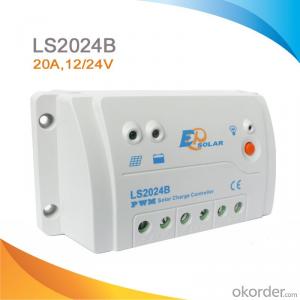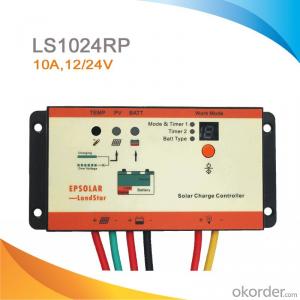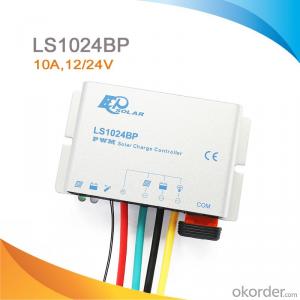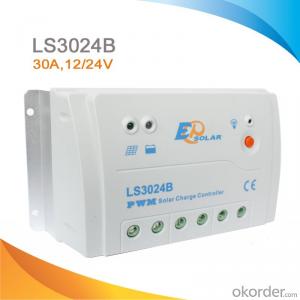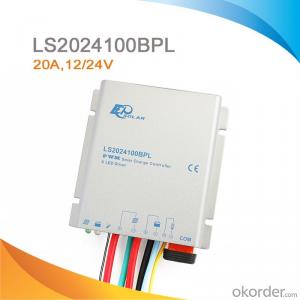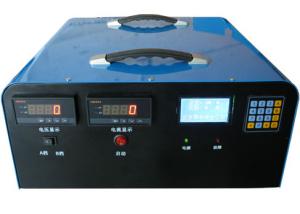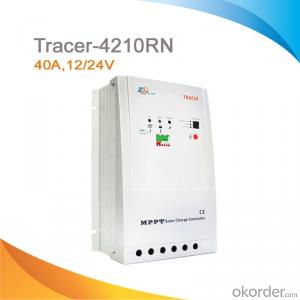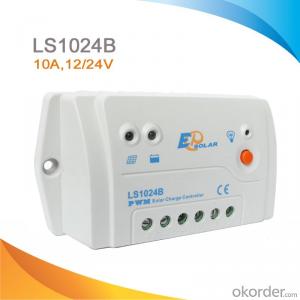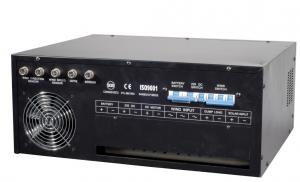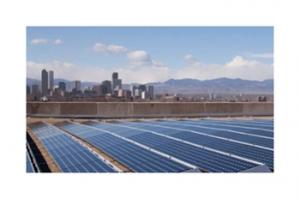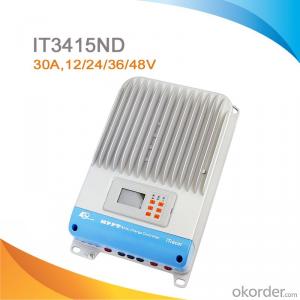Solar Controllers Rv Waterproof PWM Solar Charge Controller 20A, 12/24V, LS2024BP
- Loading Port:
- China main port
- Payment Terms:
- TT or LC
- Min Order Qty:
- -
- Supply Capability:
- -
OKorder Service Pledge
OKorder Financial Service
You Might Also Like
Features:
·12V/24V automatic identify or user-defined working voltage.
·High efficient Series PWM charging, increase the battery lifetime and improve the solar system performance.
·Use MOSFET as electronic switch, without any mechanical switch.
·Multiple load control modes, increase the flexibility of the load output
·Gel, Sealed, Flooded and user-defined battery type option.
·New SOC method of calculating accurately displays the available battery capacity.
·LandStar BP has no keys , The control function and the switch condition of the load can be modified by communication connection.
·Use of standard Modbus communication protocol for TTL-232 bus connections, communication protocol compatibility much better
·Support firmware upgrade
·Fully encapsulated PCB, IP67 protection
·Aluminumhousing
More powerful function via MT50 or PC
·Diversified load control modes : Manual, Light ON/OFF, Light ON+ Timer, Time Control
·Battery type selection: Gel, sealed, flooded and User type
·Real-time monitor
·Programmable parameters
·LVD or SOC load disconnect function
·Energy statistics function
Electronic Protections:
·PV array short circuit
·Over discharging
·Over charging
·Load overload
·Load short circuit
·PV reverse polarity
·Battery reverse polarity
·Overheating
Specification:
Electrical parameters | LS1024BP | LS2024BP |
Nominal System Voltage | 12 / 24V auto work | |
Rated Battery Current | 10A | 20A |
Maximum battery voltage | 34V | |
Grounding | Common positive | |
Self-consumption | 8.4mA(12V),7.8mA(24V) | |
Temp. compensation | -3mV/℃/2V(25℃ ref) | |
Equalize charging voltage | Sealed: 14.6V, Flooded: 14.8V, User-defined: 9~17V | |
Boost charging voltage | Gel: 14.2V, Sealed: 14.4V, Flooded: 14.6V, User-defined: 9~17V | |
Float charging voltage | Gel /Sealed /Flooded: 13.8V, User-defined: 9~17V | |
Low voltage reconnect voltage | Gel /Sealed /Flooded: 12.6V, User-defined: 9~17V | |
Low voltage disconnect voltage | Gel /Sealed /Flooded: 11.1V, User-defined: 9~17V | |
Working temp. | -35℃~+55℃ | |
Humidity | ≤95% (NC) | |
Enclosure | IP67 | |
Dimension | 108.5 x 64.5 x 25.6mm | 139 x 76.5 x 28mm |
Terminal | 4mm2 | 6mm2 |
Net weight | 0.4kg | 0.6kg |
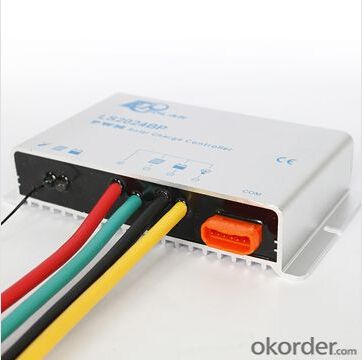
FAQ:
Q1. What is the voltage?
A1. Our 45/60A solar charge controller is 12/24/36/48V auto work.
Q2. What is the difference between MPPT&PWM?
A2. MPPT has higher efficiency, it can track the max power point and won't waste energy.
Q3. What is the efficiency of the MPPT controller?
A3. MPPT>99%, peak conversion efficiency>98%.
Q4. What is the waranty of product?
A4. 12 months.
Q5. What protection does your MPPT controller have?
A5. PV array short circuit, PV reverse polarity, Battery reverse polarity, Over charging, Output short circuit.
- Q: What is the maximum power rating a solar controller can handle?
- The maximum power rating a solar controller can handle depends on its specific design and specifications. It can range from a few watts for small-scale systems to several kilowatts for larger installations.
- Q: How does a solar controller handle battery low voltage disconnect recovery?
- Battery low voltage disconnect recovery is managed by a solar controller through the monitoring of the battery's voltage in relation to the solar system. When the battery's voltage falls below a predetermined threshold, typically around 11.5 to 12 volts, the solar controller will separate the battery from the load in order to prevent further discharge. Once the battery is separated, the solar controller will continuously observe the battery's voltage, waiting for it to rise above a specific level referred to as the recovery voltage. Only then will the solar controller reconnect the battery to the load. Throughout the recovery phase, the solar controller will gradually increase the voltage supplied to the battery, ensuring a controlled and safe reconnection process that avoids sudden power surges. This careful approach prevents any potential harm to both the battery and the connected devices. The solar controller's capacity to handle battery low voltage disconnect recovery guarantees the protection of the battery against over-discharge, which can result in irreversible damage and reduced battery performance. By appropriately disconnecting and reconnecting the battery at suitable voltage levels, the solar controller actively contributes to extending the battery's lifespan and maximizing the efficiency of the entire solar system.
- Q: Can a solar controller handle power surges from the charge controller?
- No, a solar controller is not designed to handle power surges from the charge controller. The solar controller's primary function is to regulate and control the charging process of the batteries, while the charge controller is responsible for managing the power flow between the solar panels and the batteries. Any power surges from the charge controller would require additional surge protection devices or measures to prevent damage to the solar controller.
- Q: How do I ensure proper grounding of a solar controller system?
- To ensure proper grounding of a solar controller system, there are a few key steps you should follow. First, make sure to connect the grounding wire from the solar controller to a grounding electrode, such as a grounding rod or a metal water pipe. This will provide a direct path for any electrical faults to dissipate safely into the ground. Additionally, ensure that the grounding wire is properly sized according to the manufacturer's recommendations. It is also important to regularly inspect the grounding system for any signs of damage or corrosion and fix them promptly. Lastly, consult local electrical codes and regulations to ensure compliance with specific grounding requirements in your area.
- Q: Can a solar controller be used in off-grid solar systems?
- Yes, a solar controller can be used in off-grid solar systems. In fact, it is an essential component of any off-grid solar system. A solar controller, also known as a charge controller, regulates the amount of charge going into the battery bank from the solar panels. It prevents overcharging of the batteries during periods of high solar input and protects the batteries from being completely drained during periods of low solar input. This helps to prolong the lifespan of the batteries and ensures their optimal performance. Additionally, solar controllers often have additional features such as load control and monitoring capabilities, making them an integral part of off-grid solar systems.
- Q: Can a solar controller handle power fluctuations from the inverter?
- Yes, a solar controller is designed to handle power fluctuations from the inverter. It regulates and controls the flow of electricity between the solar panels, batteries, and inverter, ensuring stable and consistent power supply even in the presence of fluctuations.
- Q: What is the purpose of a solar controller?
- The purpose of a solar controller is to regulate and optimize the charging and discharging of solar batteries, ensuring efficient and safe operation of solar power systems.
- Q: Can a solar controller be used in a solar-powered data center?
- Yes, a solar controller can be used in a solar-powered data center. A solar controller regulates the charging and discharging of batteries in a solar power system. In a solar-powered data center, the solar controller plays a crucial role in managing the flow of energy from the solar panels to the batteries, ensuring optimal use of the available solar power.
- Q: Can a solar controller be used with a solar-powered security camera system?
- Yes, a solar controller can be used with a solar-powered security camera system. A solar controller regulates the flow of power from the solar panels to the battery, ensuring optimal charging and preventing overcharging or damage. Therefore, it is essential for maintaining the efficiency and longevity of a solar-powered security camera system.
- Q: How does a solar controller handle reverse current flow from batteries to solar panels?
- A solar controller, also known as a charge controller, is an essential component in solar power systems. Its primary function is to regulate the charge coming from solar panels to batteries, ensuring optimal charging and preventing overcharging or damage to the batteries. When it comes to reverse current flow from batteries to solar panels, a solar controller handles it by utilizing a blocking diode or a solid-state relay. These components are designed to prevent current flow in the opposite direction, thereby safeguarding the solar panels from any damage that could be caused by the battery's discharge. The blocking diode acts as a one-way valve for the electricity, allowing the current to flow from the solar panels to the batteries but blocking any reverse current. It is installed in the wiring between the batteries and solar panels, effectively preventing the battery's discharge from flowing back into the panels. Similarly, a solid-state relay can be used in more advanced solar controllers. These relays use electronic switching components to control the direction of current flow. In the case of reverse current, the solid-state relay will detect it and prevent it from reaching the solar panels. By incorporating either a blocking diode or a solid-state relay, a solar controller effectively mitigates the risk of reverse current flow from batteries to solar panels. This ensures the longevity and efficiency of the solar power system by maintaining the intended flow of energy and protecting the panels from potential damage.
Send your message to us
Solar Controllers Rv Waterproof PWM Solar Charge Controller 20A, 12/24V, LS2024BP
- Loading Port:
- China main port
- Payment Terms:
- TT or LC
- Min Order Qty:
- -
- Supply Capability:
- -
OKorder Service Pledge
OKorder Financial Service
Similar products
Hot products
Hot Searches
Related keywords
